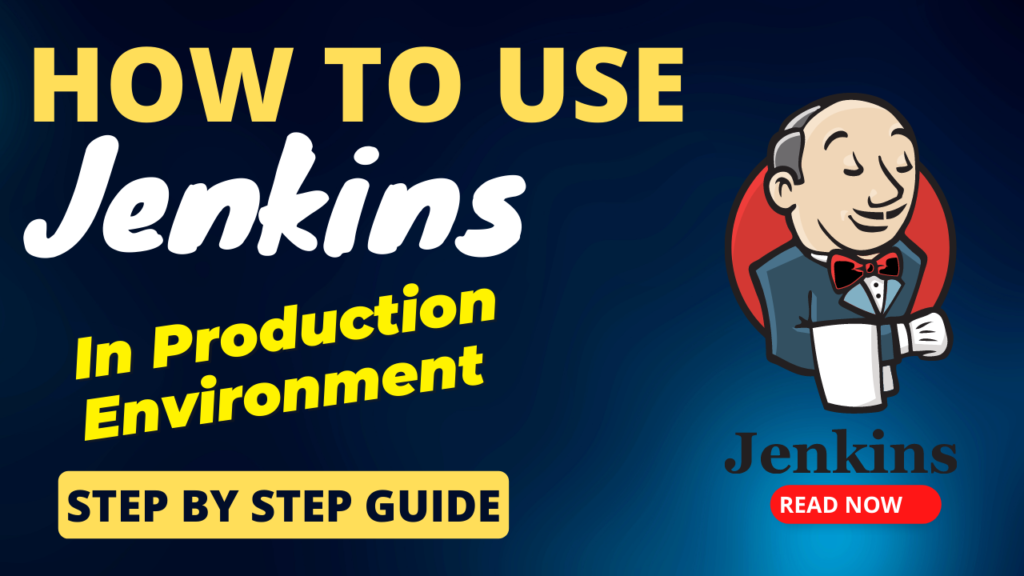What is Jenkins?
Jenkins is a popular open-source continuous integration (CI) server. It can be used to automate the build, test, and deployment of software.
In this blog post, we will discuss the step-by-step process (lifecycle) of using Jenkins in a production environment.

Steps on how to use Jenkins in a production environment:
- Plan your Jenkins deployment. This includes deciding what you want to automate, how you want to automate it, and what resources you need.
- Install Jenkins. This can be done on a local machine or on a server.
- Configure Jenkins. This includes setting up your build jobs, defining your test suites, and configuring your deployment targets.
- Deploy your software. This can be done manually or automatically.
- Monitor your software. This includes monitoring the health of your applications, the performance of your infrastructure, and the security of your environment.
Detailed explanations of each step:
1. Plan your Jenkins deployment.
The first step is to plan your Jenkins deployment. This includes deciding what you want to automate, how you want to automate it, and what resources you need.
- What do you want to automate? This could include things like building your software, running tests, and deploying your software to production.
- How do you want to automate it? You can use Jenkins to automate these tasks using a variety of plugins.
- What resources do you need? You will need a server to run Jenkins, and you may also need to purchase additional plugins.
2. Install Jenkins.
Once you have planned your deployment, you can install Jenkins. This can be done on a local machine or on a server.
- To install Jenkins on a local machine, you can download the Jenkins installer from the Jenkins website.
- To install Jenkins on a server, you can use a variety of methods, such as using a package manager or manually installing it.
3. Configure Jenkins.
Once you have installed Jenkins, you need to configure it. This includes setting up your build jobs, defining your test suites, and configuring your deployment targets.
- To set up a build job, you need to create a job configuration file. This file specifies the steps that Jenkins should take to build your software.
- To define a test suite, you need to create a test suite configuration file. This file specifies the tests that Jenkins should run.
- To configure your deployment targets, you need to specify the locations where you want to deploy your software.
4. Deploy your software.
Once you have configured Jenkins, you can deploy your software. This can be done manually or automatically.
- To deploy your software manually, you can click the “Build Now” button in the Jenkins dashboard.
- To deploy your software automatically, you can configure a build job to trigger a deployment when the build is successful.
5. Monitor your software.
Once you have deployed your software, you need to monitor it to make sure that it is working properly. This includes monitoring the health of your applications, the performance of your infrastructure, and the security of your environment.
- To monitor the health of your applications, you can use a variety of tools, such as Prometheus and Grafana.
- To monitor the performance of your infrastructure, you can use a variety of tools, such as Nagios and Munin.
- To monitor the security of your environment, you can use a variety of tools, such as Nessus and QualysGuard.
Summary:
Jenkins is a powerful tool that can help you automate the build, test, and deployment of software. By following the steps outlined in this blog post, you can successfully use Jenkins in a production environment.
If you are interested in learning more about Jenkins, I encourage you to visit the Jenkins website. You can also find a variety of Jenkins tutorials and resources online.
Thanks for reading!
If you found this post helpful, please like and Share. I’ll see you in the next post.
Don’t forget to connect with me on below platforms (Youtube & Instagram) for more “To The Point” Learning.
Telegram: https://t.me/t3pacademy & https://t.me/LearnDevOpsForFree
Youtube: https://www.youtube.com/@T3Ptech
Instagram: https://instagram.com/t3pacademy